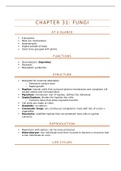1
NR 602 FINAL EXAM QUESTIONS BANK (129 Q&A) /
NR602 EXAM QUESTIONS BANK (129 Q&A):RATED A
2022 |CHAMBERLAIN
1. The following are risk factors for hypertension in children and teens (choose all that
apply): being obese. being exposed to second-hand smoke.
2. In evaluating a 9-year-old child with a healthy BMI during a well visit, a comprehensive
cardiovascular evaluation should be conducted by the following methods (choose all that apply):
Obtain fasting lipid profile. / Assess diet and physical activity.
3. At what age is it appropriate to recommend dietary changes to parents if overweight or
obesity is a concern?
12 months old
4. The following are risk factors for type 2 diabetes mellitus
in children and teens (choose all that
apply): hyperinsulinemia: abnormal weight-to-height ratio.: Native American ancestry.
5. Screening children with a known risk factor for type 2 diabetes mellitus is recommended at age 10 or at
onset of puberty, and should be repeated how often?
every year.
6. Prediabetes in children is defined as (choose all that apply):
impaired fasting glucose (glucose level ≥100 mg/dL or 6.2 mmol/L) but ≤125 mg/dL or 7
mmol/L). impaired glucose tolerance (2-hour postprandial ≥140-199 mg/dL or 7.8 mmol/L-11
mmol/L).
7. Risk factors for dyslipidemia in children include (choose all that
apply): family history of lipid abnormalities.
family history of type 2 diabetes mellitus.
8. Screening cholesterol levels in children with one or more risk factors begins at
what age? . 2 years
8. An acceptable level of total cholesterol (mg/dL) in children and teens is:
<170 mg/dL or 9.4 mmol/L.
9. low birth weight, and poor infant growth are risk factors for type 2
diabetes True
10. Prediabetes in children is defined as impaired fasting glucose (glucose level ≥100 mg/dL or 5.6 mmol/L
but
, 2
≤125 mg/dL or 7 mmol/L) or impaired glucose tolerance (2-hour postprandial ≥140-199 mg/dL or 7.8
mmol/L-11 mmol/L) or an A1C of 5.7% to 6.4%.
True
11. Screening for type 2 diabetes begins at age _10 or at onset of puberty and continues every 2
years untiladulthood; at that point, the adult guidelines should be followed.
12. The AAP screening guidelines for total cholesterol levels in children and adolescents aged 2 to 19
years old are as follows: Acceptable level is < 170 mg/dL (<9.4 mmol/L), borderline is 170-199
mg/dL (9.4 mmol/L-11 mmol/L), and high is >200 mg/dL (≥11.1 mmol/L)
13. Children should be screened for family history of cardiovascular disease (CVD) beginning at age _3
and should be periodically updated annually or as required by risk factors during non-urgent health
visits.
14. For at-risk children, fasting lipid levels should be tested after __2 years of age (but no later than 10
years ofage) and should be retested in 3-5 years if the values fall within the reference range.
15. Body mass index (BMI) should be measured beginning at age 2 .
, 3
16. For children between 12 months and 2 years of age for whom overweight or obesity is a concern, the use
of
REDUCED fat milk would be appropriate.
17. Beginning at age _5 if BMI is ≥ 85th percentile, intensify dietary and activity changes to the parent.
18. Infection with Corynebacterium diphtheriae usually
causes: Pseudomembranous pharyngitis
19. The tetanus infection is caused byCLOSTRIDIUM TETANI , an anaerobic, gram-positive,
spore-forming rod. This organism is found in soil and is particularly potent in manure.
20. Sources of lead that can contribute to plumbism include select traditional remedies such as azarcon
and greta. True
21. Patients with plumbism present with which kind of
anemia? Microcytic, hypochromic
22. Intervention for a child with a lead level of 5 to 44 mcg/dL usually includes all of the following
except: Chelation therapy
23. Ingested lead inactivates heme synthesis by inhibiting the insertion of iron into the protoporphyrin
ring. This leads to the development of what kind of anemia?
microcytic, hypochromic
24. Basophilic stippling is often noted on red blood cell morphology in lead poisoning.
25. Lead is significantly toxic to the solid organs, bones, and nervous system
26. Long-term complications of LEAD poisoning include behavior or attention problems, poor
academic performance, hearing problems, kidney damage, reduced IQ, and slowed body growth.
27. Unless deleading procedures have been performed, however, most homes built before 1957 contain
lead-based paint.
28. A diet low in calcium, iron, zinc, magnesium, and copper and high in fat, which is a typical diet for
children living in poverty , enhances oral lead absorption
29. In older homes, the point of greatest risk is the __window because their sills and the putty have high
lead concentration. Because toddlers (age 2 to 3) are the ideal height to reach them and are often
drawn to open ones, they are at greatest risk and summer is the riskiest season.
window
30. Symptoms of elevated LEAD levels include abdominal pain and cramping, aggressive behavior,
anemia, constipation, difficulty sleeping, headaches, irritability, loss of previous developmental skills in
young children, lowappetite and energy, and reduced sensations. Very high levels can result in vomiting,
staggering walk, muscle weakness, seizures, or coma.
31. A measure of 5 mcg/dL is now used to identify children with elevated blood lead levels.
32. Most children with lead levels of 5-44 mcg/dL are treated with removal from the source, improved
nutrition, and
IRON therapy.
33. Those with lead levels of 45-50 mcg/dL are treated with a CHELATION agent such as succimer,





